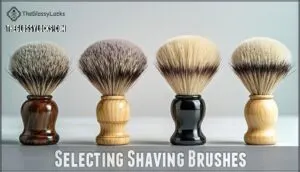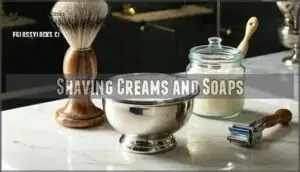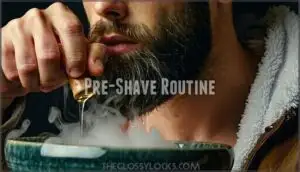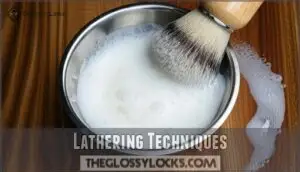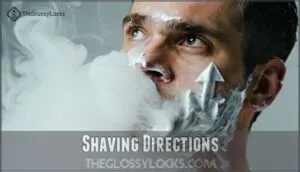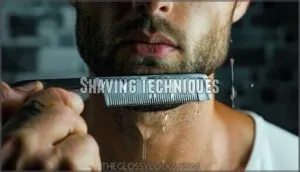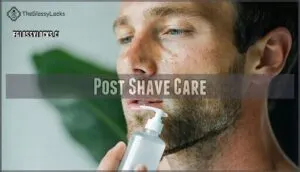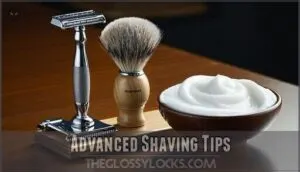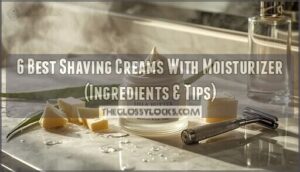This site is supported by our readers. We may earn a commission, at no cost to you, if you purchase through links.
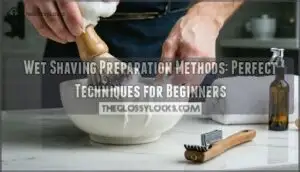 Mastering wet shaving preparation methods starts with three key steps that’ll transform your routine.
Mastering wet shaving preparation methods starts with three key steps that’ll transform your routine.
First, soften your whiskers with hot water or a warm towel for two minutes—think of it as warming up before a workout. Next, create a rich lather using quality shaving cream and a brush, working it into your beard like you’re painting a masterpiece.
Finally, map your grain pattern by running your hand across your face to understand which direction your hair grows. These fundamentals work together like a three-legged stool, each supporting the others.
The right preparation makes all the difference between a rushed hack job and a smooth, comfortable shave that sets the tone for your entire day.
Table Of Contents
- Key Takeaways
- Wet Shaving Basics
- Choosing Right Tools
- Preparation Methods
- Shaving Techniques
- Post Shave Care
- Advanced Shaving Tips
- Frequently Asked Questions (FAQs)
- How do you shave if your skin is wet?
- Why is a wet shave better?
- What is a wet shave?
- Should you shave with an electric razor or wet?
- How do you wet shave a hair brush?
- How do I get the best shave possible?
- How do you prep for wet shaving?
- Is it better to wet shave with hot or cold water?
- How do you prep your face for shaving?
- How do you wet shave without irritation?
- Conclusion
Key Takeaways
- You’ll transform your routine by softening whiskers with hot water for two minutes, creating rich lather with quality cream and brush, and mapping your grain pattern to understand hair growth direction—these three steps work together for consistently smooth shaves.
- You’ll get superior results with wet shaving tools like safety razors and badger brushes compared to cartridge razors, saving money long-term while reducing skin irritation through proper technique and quality equipment.
- You’ll avoid common mistakes by using light pressure, maintaining proper blade angle, and not rushing through multiple passes—let the razor do the work instead of forcing it through stubborn whiskers.
- You’ll complete your shave with cold water to close pores and quality aftershave or moisturizer to prevent irritation, turning this daily task into a satisfying ritual that sets the tone for your entire day.
Wet Shaving Basics
You’ll discover that wet shaving transforms your morning routine from a rushed chore into a satisfying ritual that’s been perfected over generations.
This traditional method uses a safety razor, shaving brush, and quality cream to give you the closest shave possible while saving money over time.
History of Wet Shaving
Someone once said that everything old becomes new again, and wet shaving proves this perfectly.
Traditional methods dominated for centuries until disposable dominance took over in the 1900s.
Now you’re witnessing a wet shaving comeback as people rediscover this shaving tradition.
The cultural significance remains strong—razor evolution shows we’ve come full circle in shaving history.
Early examples include ancient Egyptians shaving for hygiene and religious purposes.
Benefits of Wet Shaving
Beyond the traditional grooming ritual, wet shaving delivers tangible benefits that transform your daily routine.
Wet shaving transforms your morning routine from a rushed chore into a satisfying ritual perfected over generations.
You’ll discover why generations swore by this method through practical advantages that extend far beyond the bathroom mirror.
- Reduced Irritation: Proper shaving preparation with quality creams creates a protective barrier, preventing razor burn and ingrown hairs while promoting skin health
- Cost Efficiency: Safety razor blades cost pennies compared to cartridge refills, saving hundreds annually without compromising your smooth shave
- Environmental Impact: Ditch plastic waste from disposables and join the sustainable shaving community that values quality over convenience
- Skin Hydration: Traditional methods emphasize irritation prevention through moisturizing ingredients that nourish your skin with every shave
Essential Tools for Wet Shaving
Getting the right gear makes wet shaving feel less like a chore and more like a ritual.
You’ll need a safety razor or straight razor, plus a quality shaving brush to work up that perfect lather.
Choose shaving soap or shaving cream with natural soap ingredients, and don’t forget aftershave balm.
Razor materials and brush types matter for blade sharpness and comfort. Many prefer a classic shaving tool for its durability.
Choosing Right Tools
You’ll find that picking the right shaving tools makes the difference between a smooth, comfortable shave and a frustrating experience that leaves your skin irritated.
The key is understanding how safety razors, brushes, and shaving creams work together to give you the close, traditional shave your grandfather probably took for granted, which relies on a traditional shave.
Safety Razors Vs Cartridge Razors
When choosing between safety razors and cartridge razors, you’ll face a trade-off between convenience and long-term benefits.
Safety razors offer superior shave closeness and dramatically lower blade cost over time, plus minimal environmental impact.
However, they require a steeper learning curve and more technique to avoid razor burn.
Cartridge razors provide instant convenience but cost substantially more long-term.
Some users find that safety razors reduce skin irritation compared to cartridge options.
Selecting Shaving Brushes
Your shaving brush choice affects your entire wet shaving experience.
Each brush hair type offers unique benefits that match different preferences and skin types.
- Badger brush – Premium softness with excellent water retention, perfect for sensitive skin
- Boar brush – Firmer bristles provide natural exfoliation, ideal for thick beards
- Synthetic brush – Cruelty-free option with quick-drying properties and consistent performance
- Knot size – Larger knots hold more lather, smaller ones offer precision control
Handle material and brush density impact comfort and durability.
Consider how bristle loft affects precision.
Proper brush maintenance extends lifespan substantially.
Shaving Creams and Soaps
Both shaving cream and shaving soap create protective lather, but they work differently.
Shaving cream lathers easily with your shaving brush, while shaving soap needs more water and practice.
Soap benefits include longer-lasting value and concentrated ingredients.
Shaving cream also offers skin hydration benefits.
Consider your skin types when choosing – sensitive skin often prefers cream’s gentler lather quality, while soap offers richer scent profiles.
Preparation Methods
Getting your face ready for wet shaving makes the difference between a rough scrape and a smooth shave.
You’ll need to soften your whiskers, warm your skin, and create the perfect lather that protects while you work.
Pre-Shave Routine
Proper face preparation sets the foundation for your best shave yet.
Start with hot water to open pores and achieve skin hydration. Apply preshave oil for beard softening and enhanced glide.
You can find various oil products online. A hot towel treatment provides exfoliation benefits while further preparing your skin.
This oil application step reduces friction and creates the perfect canvas for lathering.
Lathering Techniques
Your shaving brush needs proper brush loading to create quality lather.
Soak your brush for five minutes, then swirl it over shaving soap for thirty seconds.
Add water drops gradually until you achieve proper lather consistency.
Face lathering works well for beginners, though bowl lathering gives better control.
The key is finding the right lather hydration balance.
Shaving Directions
Your rich lather’s ready, but where do you actually drag that razor? Mapping your beard growth patterns makes all the difference between a smooth shave and razor burn city.
Start by understanding these directional basics:
- With the grain reduces irritation on your first pass
- Across the grain offers a closer shave for round two
- Against the grain delivers maximum closeness but requires caution on sensitive areas
Shaving Techniques
Now that you’ve prepared your face and lather, it’s time to master the actual shaving technique.
The way you hold your razor and make each stroke determines whether you’ll get a smooth, comfortable shave or end up with nicks and irritation.
Holding The Razor
How can you master the razor without feeling like you’re wrestling a slippery fish? The secret lies in finding your sweet spot between control and comfort.
Your grip pressure should feel firm but relaxed, like holding a pencil during an important exam. Many seasoned shavers recommend focusing on safe blade handling to minimize the risk of cuts.
| Grip Aspect | Technique |
|---|---|
| Hand Position | Hold razor type at handle base with thumb and fingers |
| Grip Pressure | Apply light, steady pressure – avoid white knuckles |
| Angle Control | Maintain 30-45 degree shaving angle consistently |
| Hand Steadiness | Keep wrist straight, move from shoulder and elbow |
| Razor Balance | Let blade sharpness do the work, not force |
Shaving Against The Grain
Once you’ve mastered holding your razor correctly, you’re ready to explore shaving against the grain for that ultra-smooth finish.
This advanced technique requires patience and proper preparation.
Here’s your step-by-step approach to ATG shaving:
- Complete your first pass with the grain using proper lathering technique
- Re-lather thoroughly for skin protection between multiple passes
- Adjust your blade angle slightly flatter than your initial shaving angle
- Test skin sensitivity on less sensitive areas first
- Skip ATG on problem areas like your neck if you experience irritation
Remember, ATG benefits include closer shaves, but ATG risks involve increased irritation.
Start slowly with these shaving techniques.
Avoiding Common Mistakes
Three critical shaving mistakes destroy your experience: applying too much pressure crushes skin, wrong blade angle causes razor burn, and excessive pass repetition irritates.
Don’t stretch skin aggressively or skip rinsing frequency between strokes.
These shaving techniques require patience—rushing leads to cuts and irritation.
Master proper skin protection by letting the razor work, not forcing it through stubborn whiskers, and remember that proper skin protection is key to a good shave.
Post Shave Care
After you’ve finished shaving, your skin needs proper care to stay healthy and comfortable.
Rinsing with cold water closes your pores, while applying aftershave or moisturizer prevents irritation and keeps your skin smooth.
Moisturizing The Skin
Your skin craves hydration after shaving, so don’t skip this step.
Pat your face dry with a clean towel, then apply a quality moisturizer or post-shave balm.
Look for ingredients like aloe vera, glycerin, or shea butter that restore moisture lost during your preshave routine and shaving process.
These application techniques lock in hydration and prepare your skin for the day ahead.
For ideal results, consider using alcohol-free aftershave to keep skin hydrated and smooth.
Reducing Irritation
Beyond proper moisturizing, you’ll want to tackle skin irritation head-on.
Cool ingredients like cucumber soothe razor burn effectively. Check product ingredients carefully – avoid fragrances and alcohol that aggravate sensitive skin.
Apply aftershave balm with colloidal oatmeal for anti-inflammatory benefits. Control blade angle and pressure during shaving to prevent irritation.
Your shaving cream choice matters too.
Advanced Shaving Tips
Once you’ve mastered the basic wet shaving techniques, you’re ready to explore advanced methods that can transform your daily routine into a truly personalized experience.
These advanced tips will help you fine-tune your blade selection, maintain your equipment properly, and create the perfect shave that matches your unique skin and hair type, leading to a perfect shave.
Customizing Blade Types
Finding your perfect razor blades requires experimenting with different blade materials and coatings.
Swedish steel offers durability, while platinum coatings provide smoothness.
Test various brands to discover what works with your skin type and hair thickness.
Double-edge blades suit most safety razors, but single-edge options reduce nicks on tricky contours.
Blade aggressiveness varies substantially between manufacturers.
Maintaining Razor Sharpness
Your razor blades need regular care to stay sharp and effective.
Stropping techniques using leather polish the edge after each shave, while honing frequency depends on usage – typically every few months.
Proper blade storage in oil prevents rust, and thorough razor cleaning removes buildup, with a focus on edge alignment during maintenance.
Proper drying prevents rust on your blades, which is crucial for longevity and to prevent irritation during shaving, and replace razor blades when they tug or cause irritation.
Enhancing Shaving Experience
Sharp blades work best when you focus on the complete wet shaving experience.
Your shaving comfort depends on finding the right blade angle and understanding your skin sensitivity.
Razor weight affects control, while quality aftershave balm soothes irritation.
Transform your routine with these game-changers:
- Premium shaving soap creates richer lather than basic cream
- A quality shaving brush elevates your shaving preparation ritual
- Consistent wet shaving technique builds confidence and skill
Frequently Asked Questions (FAQs)
How do you shave if your skin is wet?
Gentle guidance guarantees great grooming when you’re shaving wet skin.
You’ll apply shaving cream evenly, hold your razor at thirty to forty-five degrees, use light pressure, and follow hair’s natural growth direction.
For smooth results, these steps work together to provide the best outcome, with great grooming as the ultimate goal.
Why is a wet shave better?
You’ll get a closer, smoother shave with less irritation when wet shaving.
The water and cream create better lubrication, while quality razors cut cleaner than disposables.
Your skin stays healthier too.
What is a wet shave?
A wet shave uses water, shaving cream or soap, and a traditional razor like a safety or straight razor.
You’ll lather up with a brush, then shave methodically for that classic, smooth finish your grandfather knew, which involves a traditional razor.
Should you shave with an electric razor or wet?
Electric razors seem convenient, but wet shaving delivers superior results.
You’ll get a closer, smoother shave with less irritation.
While electric saves time, wet shaving’s precision and skin benefits make it worth the extra effort.
How do you wet shave a hair brush?
Soak your shaving brush in warm water for two to three minutes before use.
This softens the bristles and helps create a rich, thick lather when you apply shaving cream or soap.
How do I get the best shave possible?
Perfect shaves aren’t accidents—they’re earned.
Prep your face with hot water, build thick lather, shave with the grain using light pressure, then finish cold.
Quality tools matter, but technique transforms your routine into art.
How do you prep for wet shaving?
Start by washing your face with hot water to open pores and soften whiskers.
You’ll want to soak your brush in warm water too, then apply a hot towel for extra softening if time allows.
Is it better to wet shave with hot or cold water?
Hot water wins hands down for wet shaving prep.
It opens your pores, softens whiskers, and makes everything easier.
Save cold water for the final rinse to close pores and tighten skin afterward, using cold water only at the end.
How do you prep your face for shaving?
Wash your face with warm water to soften whiskers and open pores.
Pat dry gently, then apply pre-shave oil if you’ve got sensitive skin.
This creates the perfect canvas for your razor.
How do you wet shave without irritation?
Use light pressure and let your razor do the work.
Shave with the grain first, build thick lather, rinse your blade frequently.
And take your time—rushing leads to nicks and irritation.
Conclusion
Mastering wet shaving preparation methods isn’t rocket science, but it does require patience and practice.
You’ve learned the fundamentals—from softening whiskers to creating perfect lather and understanding grain patterns.
These techniques have served gentlemen well since before smartphones existed, and they’ll serve you just as faithfully.
Start with the basics, take your time, and don’t expect perfection immediately.
With consistent practice, you’ll develop muscle memory and confidence.
Soon, you’ll wonder why you ever rushed through this daily ritual before.
- https://www.instructables.com/An-In-depth-Beginners-Guide-to-Wet-Shaving/
- https://www.badgerandblade.com/forum/wiki/Getting_started_wetshaving
- https://www.trumpers.com/the-fundamental-principles-of-wet-shaving/
- https://www.gillette.co.uk/blog/how-to-shave/wet-shaving/?srsltid=AfmBOopAh_0-cmwfOxRQ9CpqkRu9146Y8b4vcbkRJ9X-oCfOMLDDEL1M
- https://www.gentjon.com/pages/gentleman-jons-guide-to-traditional-wet-shaving?srsltid=AfmBOoqZ4XHBHH68-eNqZtzYJYAtpH4ABLM3d_89z3LGMIG_U7ZVhgbo


